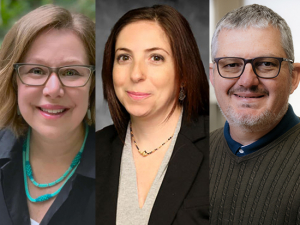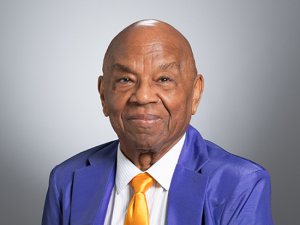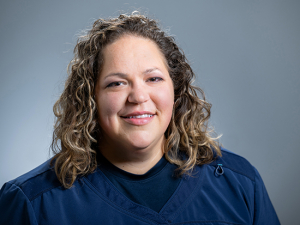 |
| From left: Timothy Garvey, Kristi Menear, David Allison, Gary Hunter and Marcas Bamman. |
Gary Hunter, Ph.D., knew pretty quickly that something was up when he stepped to the front of a packed Finley Conference Center to deliver the Center for Exercise Medicine’s recent lecture and saw his wife Becky standing in the back of the room.
“I’m a little bit nervous today,” said Hunter, professor of exercise physiology in the Department of Human Studies in the School of Education. “Not only am I talking to my esteemed colleagues, but my wife is here. She’s never heard me talk before.”
Becky was in on the ruse that Hunter would learn about only after he presented his lecture on the benefits of high-intensity exercise. That was when Center for Exercise Medicine Director Marcas Bamman, Ph.D., informed him he had just been honored in a unique way: He was the first person to speak as part of the Gary R. Hunter Distinguished Lecture series, an event that will be held every spring.
“His work is truly internationally recognized, and he’s a true innovator and leader,” Bamman said. “Our center and colleagues in this room thought it was important we recognize Gary’s contributions after nearly 30 years at UAB, and that’s why we’re naming a lecture in his honor. We’re very happy to call him one of our own.”
The Department of Human Studies, the Diabetes Research & Training Center and the Nutrition Obesity Research Center (NORC) are co-sponsors of the Hunter Distinguished Lecture.
Hunter, a Michigan native, came to UAB in 1984 and has been an international leader in exercise adaptation, energy metabolism and body composition research. He has conducted a number of studies on obesity, particularly in women, and on the aging population. Hunter has more than 250 peer-reviewed publications and has had National Institutes of Health funding throughout his career.
“It’s a phenomenal track record of productivity,” Bamman said.
| “His work is truly internationally recognized, and he’s a true innovator and leader. Our center and colleagues in this room thought it was important we recognize Gary’s contributions after nearly 30 years at UAB, and that’s why we’re naming a lecture in his honor. We’re very happy to call him one of our own.” — Marcas Bamman, Ph.D. |
“I try to convince people that high-intensity exercise is important,” Hunter said. “It’s important in helping us prevent obesity and maintaining a higher level of physical activity, which we know are important. You can’t have high fitness without high-intensity exercise.”
Impact in many areas
Hunter’s research also has been very relevant to investigators in diabetes, said Timothy Garvey, M.D., director of the Diabetes Research and Training Center.
“He’s helped out our investigators and our overall research efforts tremendously,” Garvey said. “Gary is just an exemplary scientist who adheres to the most rigorous principles. And the major benefit to UAB is that he passes this approach along to trainees and is really training the next generation of scientific leaders.”
Indeed, when Bamman asked the 80-plus people at the lecture if they had been mentored or tutored by Hunter in some way, more than half in the room raised their hand.
Bamman remembered searching for a place to attend graduate school in 1988 as a college junior and came across Hunter’s name at UAB.
“This was one place, pretty much the only place in the country that really cared about strength training, and I thought, ‘Who is this person?’” Bamman said. “I did some research and really looked into what Gary had accomplished early in his career, and decided this is where I wanted to come and train as a master’s student. It was a very fruitful time for me to be here.”
Hunter said one of his goals as a researcher always has been to pass along to others whatever knowledge he’s been able to gather. He’s always hopeful that whatever wisdom he might be able to impart will leave a positive impression.
“One of the things I’ve always believed is that if you could have even just a small impact on the people you work with — maybe you mentor them for a while — that’s how you live,” Hunter says. “You live through them. After you’re gone, whatever you’ve been able to do to help them, that’s your legacy.”
| “One of the things I’ve always believed is that if you could have even just a small impact on the people you work with — maybe you mentor them for a while — that’s how you live. You live through them. After you’re gone, whatever you’ve been able to do to help them, that’s your legacy.” — Gary Hunter |
Hunter received his bachelor’s degree from Eastern Michigan University and did his graduate training at Michigan State University, where he received his master’s and his doctorate in exercise science.
Shortly after graduating from Michigan State, Hunter became the head strength coach for the country of Bahrain and spent two years running its strength and conditioning program as part of a joint appointment with the University of South Alabama and the U.S. Sports Academy. Hunter directed the country’s sports medicine and strength training programs and coached its Olympic weight lifting team.
After his return to the United States, Hunter was on faculty at the University of Wisconsin for three years before he was recruited to UAB in 1984. He was named the National Strength and Conditioning Association’s Sports Scientist of the Year in 1994 and had visiting professorships at the University of Lausanne in Switzerland in 2000 and at Queensland University of Technology in Australia in 2005.
Champion of fitness
Hunter was a standout athlete in his youth — a fact shown in pictures provided by his wife for the lecture.
Hunter played football at Western Michigan University and football and basketball in the Air Force. He also coached the Michigan State University weight lifting team and was a weight lifting world record holder and champion in power lifting and Olympic lifting.
Co-workers and students still marvel at Hunter’s physical condition, and the 70-year-old still regularly plays basketball, among other workouts.
“The guy looks unbelievable,” Garvey said. “He’s in better shape and looks younger than many 20- and 30-year-old graduate students. He’s like an Energizer Bunny.”
Hunter said exercise training is important at any age and doubly so as people age, primarily due to muscle atrophy, which is caused partly by aging and partly by inactivity.
“If we do high-intensity training, which needs to include resistant and aerobic training, you will have more muscle for a longer period of your life,” Hunter said. “For example, if I were to quit training at my advanced age, although I’ve lost a lot of muscle, I’ll lose it much more rapidly than other 70-year-olds who have never trained. But if I keep training, I’ll end up having much more muscle than the average 70-year-old.”
Hunter said he became an exercise researcher primarily due to the influence of Roland Weinsier, M.D., Dr. P.H., who founded the Clinical Nutrition Research Center (now NORC) in 1996.
“Roland got his first R01 grant 20-plus years ago, and we started doing some work together,” Hunter says. “I happened to have an underwater weighing tank for us to use, and we grew the energy metabolism core in nutrition science. He was very interested in obesity research, and I was very interested in exercise training, so we combined our expertise and knowledge and started writing grants and doing research. One study led to another, and another and another. That’s really how it started.”
His tenacity and humble personality have made Hunter a go-to person at UAB for exercise, obesity and diabetes research for almost 30 years. But Hunter still had a hard time processing the honor his colleagues bestowed upon him.
“That they would do this for me is overwhelming,” Hunter said. “I’m totally overcome. All I can say is thank you. I’m tremendously honored.”



















